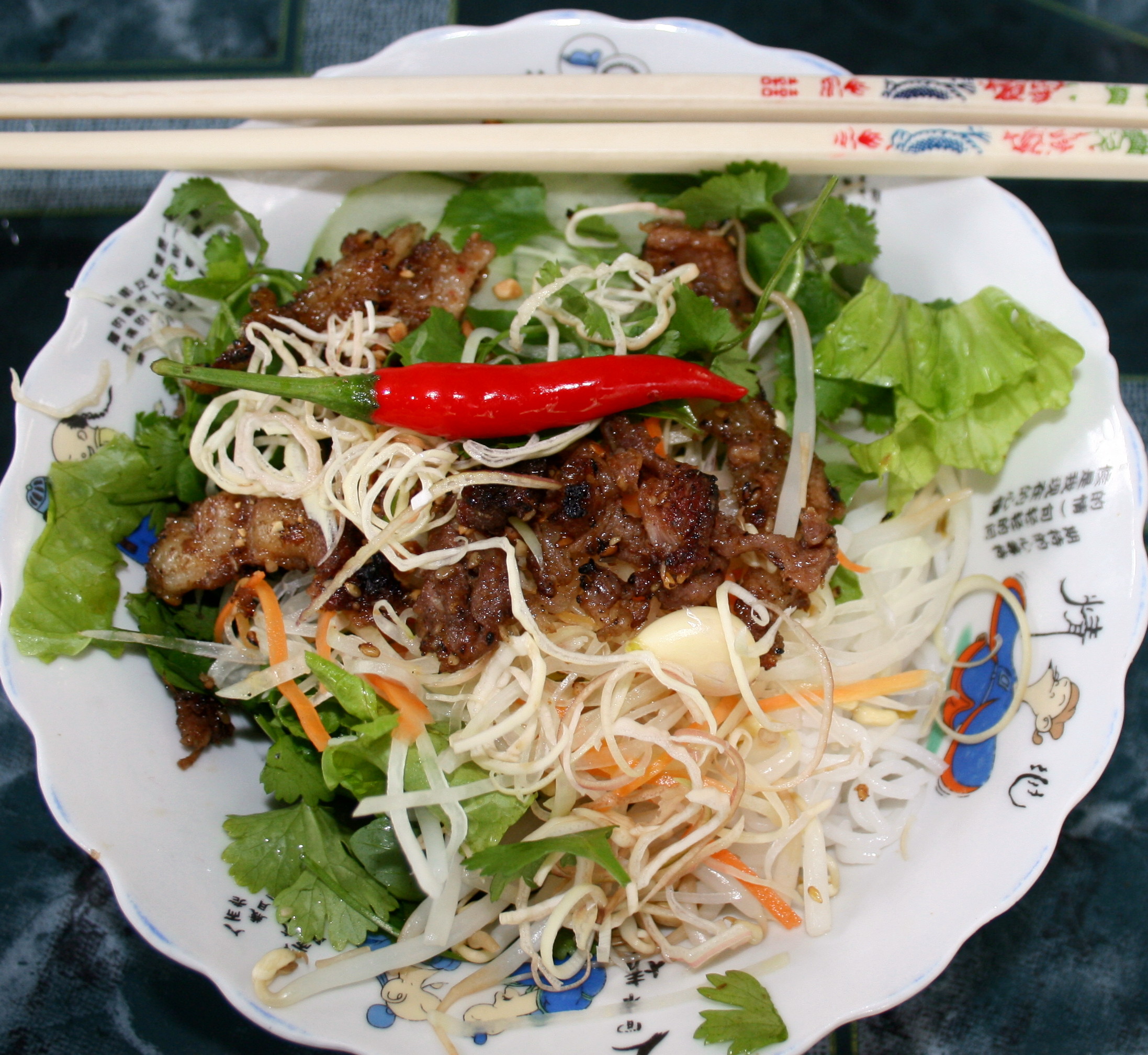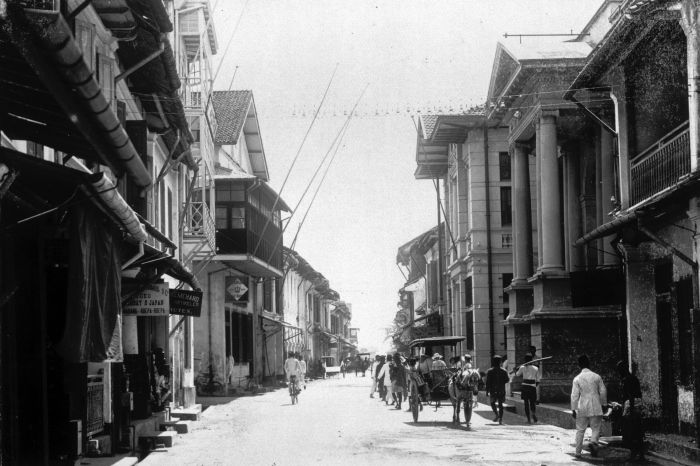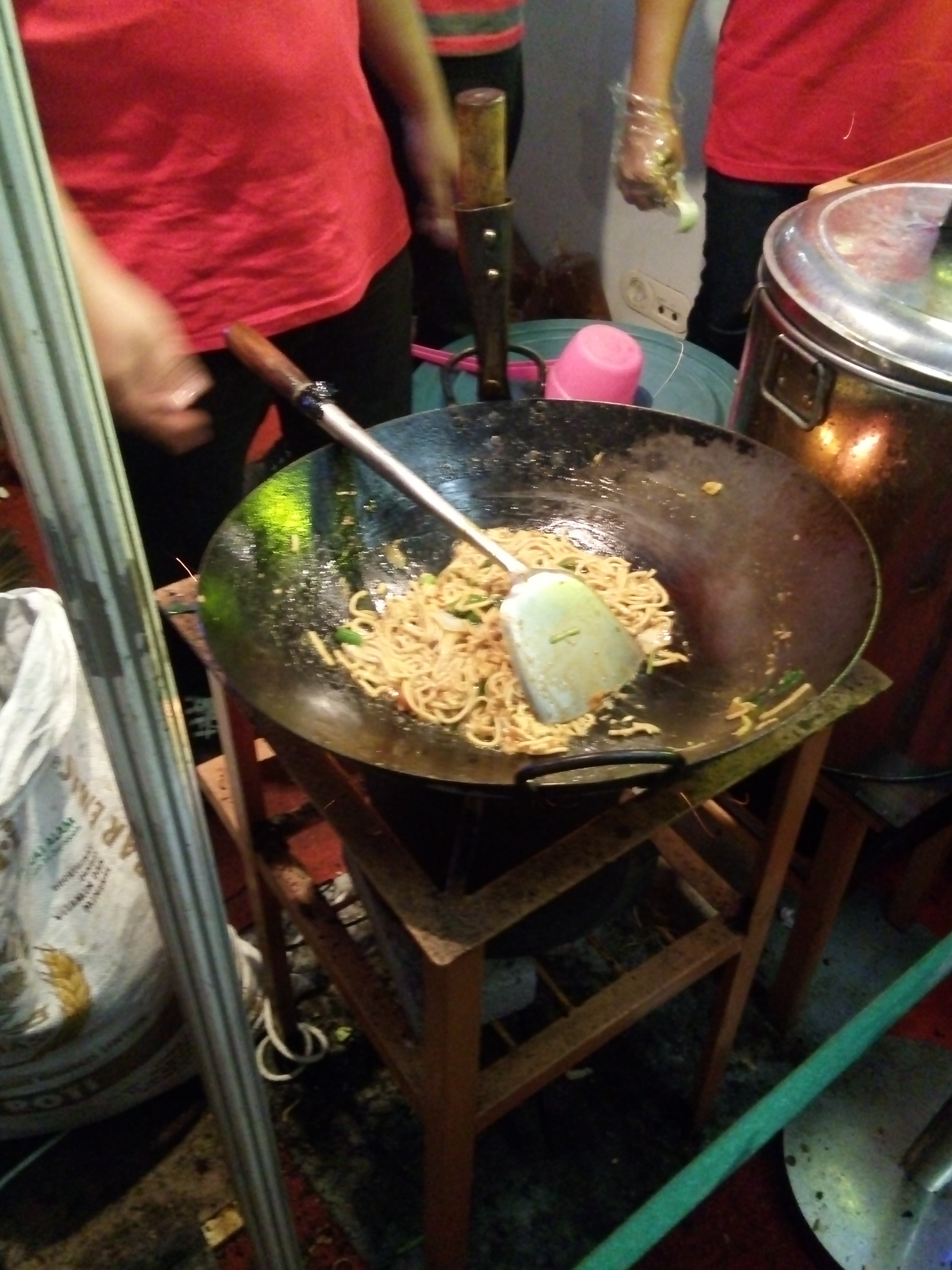|
Mie Kering
Mie Kering or Makassar Dried Noodle is a Chinese Indonesian cuisine, a type of dried noodle served with thick gravy and sliced chicken, shrimp, mushrooms, liver, and squid. It is somewhat similar to Chinese I fu mie, only the noodle is thinner. The recipe was devised by a Chinese descent, Ang Kho Tjao. He opened his noodle shop to sell his dried noodle and it gaining popularity in Makassar since early 1970s. Ang Kho Tjao passed his knowledge of the recipe to his three children namely Hengky, Awa', and Titi. After Ang Kho Tjao died, dried noodle shop business was continued by his three children who separately opened their own shop. Titi's are the most popular in Makassar, hence the name of "Mie Titi" become synonymous with Makassar dried noodle. Mie Kering is one of the most famous Makassar dishes, the others are Coto Makassar and Konro. See also * Mie goreng * Bakmi ''Bakmi'' ( and ) or ''bami'' (, , , ) are a type of wheat-based noodles derived from Chinese cooking t ... [...More Info...] [...Related Items...] OR: [Wikipedia] [Google] [Baidu] |
Indonesia
Indonesia, officially the Republic of Indonesia, is a country in Southeast Asia and Oceania, between the Indian Ocean, Indian and Pacific Ocean, Pacific oceans. Comprising over List of islands of Indonesia, 17,000 islands, including Sumatra, Java, Sulawesi, and parts of Borneo and New Guinea, Indonesia is the world's largest archipelagic state and the List of countries and dependencies by area, 14th-largest country by area, at . With over 280 million people, Indonesia is the world's List of countries and dependencies by population, fourth-most-populous country and the most populous Islam by country, Muslim-majority country. Java, the world's List of islands by population, most populous island, is home to more than half of the country's population. Indonesia operates as a Presidential system, presidential republic with an elected People's Consultative Assembly, legislature and consists of Provinces of Indonesia, 38 provinces, nine of which have Autonomous administrative divisi ... [...More Info...] [...Related Items...] OR: [Wikipedia] [Google] [Baidu] |
Noodle
Noodles are a type of food made from unleavened dough which is either rolled flat and cut, stretched, or extruded, into long strips or strings. Noodles are a staple food in many cultures and made into a variety of shapes. The most common noodles are those derived from either Chinese cuisine or Italian cuisine. Chinese noodles are known by a variety of different names, while Italian noodles are known as pasta. While long, thin strips may be the most common, many varieties of noodles are cut into waves, helices, tubes, strings, or shells, or folded over, or cut into other shapes. Noodles are usually cooked in boiling water, sometimes with cooking oil or salt added. They can also be steamed, pan-fried, deep-fried, or baked. Noodles are often served with an accompanying sauce or in a soup, the latter being known as noodle soup. Noodles can be refrigerated for short-term storage or dried and stored for future use. Etymology The word for noodles in English was borrowed in the 1 ... [...More Info...] [...Related Items...] OR: [Wikipedia] [Google] [Baidu] |
Chinese Indonesian Cuisine
Chinese Indonesian cuisine (, ) is characterized by the mixture of Chinese with local Indonesian style. Chinese Indonesians, mostly descendant of Han ethnic Hokkien and Hakka speakers, brought their legacy of Chinese cuisine, and modified some of the dishes with the addition of Indonesian ingredients, such as '' kecap manis'' (sweet soy sauce), palm sugar, peanut sauce, chili, ''santan'' (coconut milk) and local spices to form a hybrid Chinese-Indonesian cuisine. Some of the dishes and cakes share the same style as in Malaysia and Singapore, known as Nyonya cuisine by the Peranakan. Chinese cuisine legacy Chinese influences are evident in Indonesian food. The Chinese cooking style that has influenced Indonesian cuisine was mainly Hokkien cuisine. Popular Chinese Indonesian foods include '' bakmi'', '' mie ayam'', ''pangsit'', '' bakso'', ''lumpia'', '' kwetiau goreng'' and '' mie goreng''. Chinese culinary culture is particularly evident in Indonesian cuisine throug ... [...More Info...] [...Related Items...] OR: [Wikipedia] [Google] [Baidu] |
Shrimp
A shrimp (: shrimp (American English, US) or shrimps (British English, UK)) is a crustacean with an elongated body and a primarily Aquatic locomotion, swimming mode of locomotion – typically Decapods belonging to the Caridea or Dendrobranchiata, although some Shrimp#Non-decapods, crustaceans outside of this order are also referred to as "shrimp". Any small crustacean may also be referred to as "shrimp", regardless of resemblance. More narrow definitions may be restricted to Caridea, to smaller species of either of the aforementioned groups, or only the Marine life, marine species. Under a broader definition, ''shrimp'' may be synonymous with prawn, covering stalk-eyed swimming crustaceans with long, narrow muscular tails (Abdomen#Arthropoda, abdomens), long whiskers (Antenna (biology), antennae), and slender, Biramous, biramous legs. They swim forward by paddling the swimmerets on the underside of their abdomens, although their escape response is typically repeated flicks wit ... [...More Info...] [...Related Items...] OR: [Wikipedia] [Google] [Baidu] |
Squid
A squid (: squid) is a mollusc with an elongated soft body, large eyes, eight cephalopod limb, arms, and two tentacles in the orders Myopsida, Oegopsida, and Bathyteuthida (though many other molluscs within the broader Neocoleoidea are also called ''squid'' despite not strictly fitting these criteria). Like all other cephalopods, squid have a distinct head, Symmetry (biology)#Bilateral symmetry, bilateral symmetry, and a mantle (mollusc), mantle. They are mainly soft-bodied, like octopuses, but have a small internal skeleton in the form of a rod-like gladius (cephalopod), gladius or pen, made of chitin. Squid diverged from other cephalopods during the Jurassic and occupy a similar Ecological niche, role to teleost fish as open-water predators of similar size and behaviour. They play an important role in the open-water food web. The two long tentacles are used to grab prey and the eight arms to hold and control it. The beak then cuts the food into suitable size chunks for swal ... [...More Info...] [...Related Items...] OR: [Wikipedia] [Google] [Baidu] |
Chinese Cuisine
Chinese cuisine comprises cuisines originating from Greater China, China, as well as from Overseas Chinese, Chinese people from other parts of the world. Because of the Chinese diaspora and the historical power of the country, Chinese cuisine has profoundly influenced many other cuisines in Asia and beyond, with modifications made to cater to local palates. Chinese food staples such as rice, soy sauce, noodles, tea, chili oil, and tofu, and utensils such as chopsticks and the wok, can now be found worldwide. The world's earliest eating establishments recognizable as Restaurant, restaurants in the modern sense first emerged in Song dynasty China during the 11th and 12th centuries. Street food became an integral aspect of Chinese food culture during the Tang dynasty, and the street food culture of much of Southeast Asia was established by workers imported from China during the late 19th century. The preferences for seasoning and Chinese cooking techniques, cooking techniques in ... [...More Info...] [...Related Items...] OR: [Wikipedia] [Google] [Baidu] |
I Fu Mie
I, or i, is the ninth letter and the third vowel letter of the Latin alphabet, used in the modern English alphabet, the alphabets of other western European languages and others worldwide. Its name in English is ''i'' (pronounced ), plural ''ies''. Name In English, the name of the letter is the "long I" sound, pronounced . In most other languages, its name matches the letter's pronunciation in open syllables. History In the Phoenician alphabet, the letter may have originated in a hieroglyph for an arm that represented a voiced pharyngeal fricative () in Egyptian, but was reassigned to (as in English "yes") by Semites because their word for "arm" began with that sound. This letter could also be used to represent , the close front unrounded vowel, mainly in foreign words. The Greeks adopted a form of this Phoenician ''yodh'' as their letter '' iota'' () to represent , the same as in the Old Italic alphabet. In Latin (as in Modern Greek), it was also used t ... [...More Info...] [...Related Items...] OR: [Wikipedia] [Google] [Baidu] |
Chinese Indonesian
Chinese Indonesians (), or simply ''Orang Tionghoa'' or ''Tionghoa'', are Indonesians whose ancestors arrived from China at some stage in the last eight centuries. Chinese Indonesians are the fourth largest community of Overseas Chinese in the world after Thailand, Malaysia, and the United States. Chinese people and their Indonesian descendants have lived in the Indonesian archipelago since at least the 13th century. Many came initially as sojourners (temporary residents), intending to return home in their old age. Some, however, stayed in the region as economic migrants. Their population grew rapidly during the colonial period when workers were contracted from their home provinces in Southern China. Discrimination against Chinese Indonesians has occurred since the start of Dutch colonialism in the region, although government policies implemented since 1998 have attempted to redress this. Resentment of ethnic Chinese economic aptitude grew in the 1950s as Native Indonesian m ... [...More Info...] [...Related Items...] OR: [Wikipedia] [Google] [Baidu] |
Makassar
Makassar ( ), formerly Ujung Pandang ( ), is the capital of the Indonesian Provinces of Indonesia, province of South Sulawesi. It is the largest city in the region of Eastern Indonesia and the country's fifth-largest urban center after Jakarta, Surabaya, Medan, and Bandung.Ministry of Internal AffairsRegistration Book for Area Code and Data of 2013 The city is located on the southwest coast of the island of Sulawesi, facing the Makassar Strait. Throughout its history, Makassar has been an important trading port, hosting the center of the Gowa Sultanate and a Portuguese naval base before its conquest by the Dutch East India Company in the 17th century. It remained an important port in the Dutch East Indies, serving Eastern Indonesian regions with Makassarese fishers going as far south as the Australian coast. For a brief period after Independence of Indonesia, Indonesian independence, Makassar became the capital of the State of East Indonesia, during which an Makassar Uprising, u ... [...More Info...] [...Related Items...] OR: [Wikipedia] [Google] [Baidu] |
Coto Makassar
Coto Makassar or Coto Mangkasara ( Makassarese), is an Indonesian traditional soup originating from Makassar, South Sulawesi. It is a variant of '' soto,'' traditionally made with beef, offal stew with seasoned broth made from ground peanuts and spices. The main ingredient of this soup is beef, and it can be mixed with innards, such as intestine, liver, lungs, heart, tripe, or cow brain. Coto Makassar is usually served with Burasa or Ketupat rice cakes. See also *''Soto ayam'' *'' Sop saudara'', spicy Bugis-Makassar beef soup. *'' Konro'', Bugis-Makassar spicy cow's ribs soup, similar or related to ribs ''soto'' *''Tongseng'', Javanese spicy mutton soup also related to ''soto'' *''Gulai'', the Javanese ''gulai'' is soupy, similar to mutton or goat ''soto'' but slightly different in spices * List of Indonesian soups * List of soups This is a list of notable soups. Soups have been made since ancient times. Some soups are served with large chunks of meat or vegetables left ... [...More Info...] [...Related Items...] OR: [Wikipedia] [Google] [Baidu] |
Konro
Konro is an Indonesian rib soup originating with the Makassarese people of South Sulawesi. Usually this soup was made with ribs, such as spareribs or beef as main ingredient. The soup is brown-black in color and eaten either with burasa or ketupat cut into bite-size pieces or rice. The spicy and strong-tasting soup is made from a mixture of rich spices, which includes coriander, ''keluwak'' ('' Pangium edule''); a fruit that gives it its blackish color, also small amount of nutmeg, turmeric, galangal, cinnamon, tamarind, lemongrass, clove, and ''salam'' (Indonesian bayleaf). Variants Originally konro was usually served as a spicy rich soup, however today the new variation of dry konro is available, the ''konro bakar'' (grilled konro), grilled ribs marinated and coated in spices typical to the konro soup. See also * List of Indonesian soups This is a list of Indonesian soups. Indonesian cuisine is diverse, in part because Indonesia is composed of approximately 6,000 populat ... [...More Info...] [...Related Items...] OR: [Wikipedia] [Google] [Baidu] |
Mie Goreng
Mie goreng (; meaning "fried noodles"), also known as bakmi goreng, is an Indonesian stir-fried noodle dish. It is made with thin yellow noodles stir-fried in cooking oil with garlic, onion or shallots, fried prawn, chicken, beef, or sliced bakso (meatballs), chili, Chinese cabbage, cabbages, tomatoes, egg, and other vegetables. Ubiquitous in Indonesia, it is sold by food vendors from street hawkers ('' warungs'') to high-end restaurants. History In Indonesia, where mi goreng is one of the most widespread simple dishes, the dish's origin is associated with Chinese Indonesian cuisine. Chinese influences are evident in Indonesian food such as '' bakmi'', '' mi ayam'', '' pangsit'', '' bakso'', ''lumpia'', '' kwetiau goreng'', and ''mi goreng''. The dish is derived from Chinese ''chow mein'' and is believed to have been introduced by Chinese immigrants in Indonesia. Despite being influenced by Chinese cuisine, ''mi goreng'' in Indonesia has a definite Indonesian taste and h ... [...More Info...] [...Related Items...] OR: [Wikipedia] [Google] [Baidu] |







